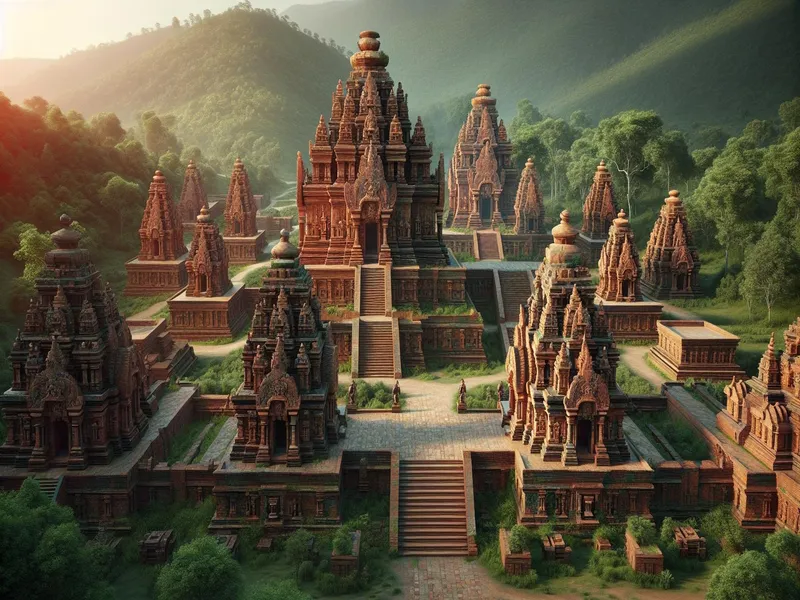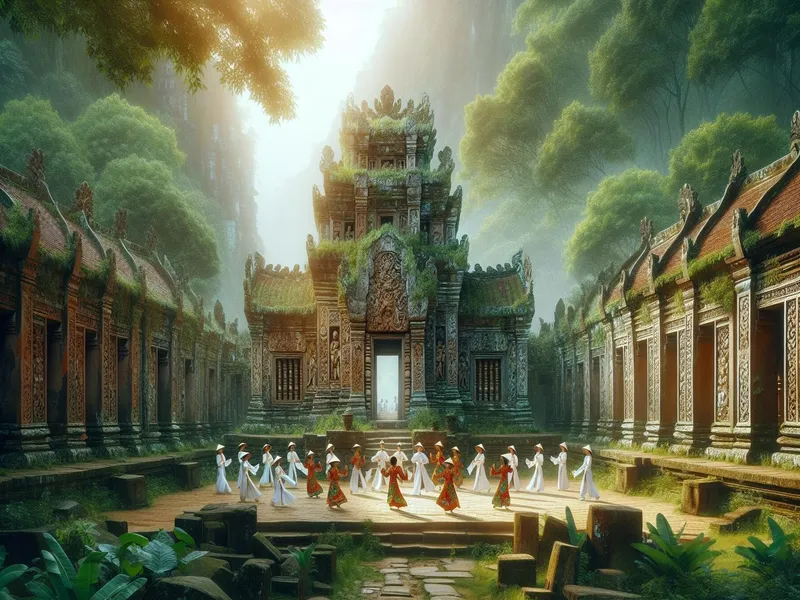the enchanting My Son temple complex in Vietnam, a UNESCO site. Explore ancient Cham civilization’s art, architecture, and serene landscapes perfect for backpacking travelers.

Historical Significance of My Son
My Son, nestled in the lush greenery of central Vietnam, isn’t just a bunch of old ruins. It’s like stepping into a time machine that whisks you back to the glory days of the Champa civilization. Imagine walking through these ancient temples with their intricate carvings—you can almost hear whispers from centuries past.
A Glimpse into Champa Civilization ️
The Cham people ruled this region between the 4th and 13th centuries. Think about it—a civilization flourishing for nearly a thousand years! They were masters of architecture and sculpture, evidenced by the stunning brickwork and sandstone carvings you’ll see at My Son.
UNESCO World Heritage Site
In 1999, UNESCO recognized My Son as a World Heritage site. This isn’t just some fancy title. It means My Son is considered important enough to humanity that it needs protection for future generations. Pretty cool, huh?
Why It Matters
- Cultural Importance: These temples are not just religious sites; they’re cultural treasures.
- Architectural Marvels: The Cham used no mortar—just bricks intricately fitted together!
- Historical Insight: You get a real feel for what life was like during the height of the Champa Empire.
Personal Anecdote
When I visited My Son last summer, I felt like Indiana Jones exploring hidden temples. As I wandered through moss-covered ruins, I couldn’t help but marvel at how these structures have stood the test of time—surviving wars and weather alike.
Fun Facts & Curiosities
- Did you know? Some believe that Hindu deities protect these temples.
- Quirky detail: Local legends say if you listen closely near certain carvings, you might hear ancient chants (I didn’t hear any, but it’s fun to imagine!).
Backpacker’s Checklist
If you’re thinking about visiting:
- Comfortable Shoes: Lots of walking involved.
- Bug Spray: Trust me on this one.
- Water Bottle: Stay hydrated in that tropical heat.
Architectural Marvels

When you step into My Son, you’re not just visiting a place; you’re traveling back in time. The architecture here is nothing short of breathtaking.
Temple Structures
The temple structures at My Son are mind-blowing. Built between the 4th and 13th centuries, these temples were dedicated to Hindu gods like Shiva. Imagine standing before towering brick edifices that have withstood centuries! The bricks fit so tightly together without mortar—it’s an ancient engineering marvel.
- Main Towers (Kalan): These acted as sanctuaries and held statues of deities.
- Subordinate Structures: Used for offerings and rituals.
- Mandapas (Assembly Halls): Where devotees gathered for prayers.
Each structure tells a story. For example, I remember walking through one tower’s doorway, feeling like Indiana Jones on an epic adventure sans the booby traps!
Art and Sculptures
If you love art, you’ll be in heaven here. The carvings and sculptures are incredibly detailed. Think intricate floral patterns, mythological animals, and depictions of Hindu gods—all carved from sandstone or made using terracotta.
- Lintels: Elaborate carvings above doorways.
- Bas-reliefs: Low-relief sculptures depicting scenes from Hindu epics.
- Statues: Deity figures that once graced every corner.
I found myself mesmerized by a bas-relief showing warriors in battle—a snapshot of life hundreds of years ago. It’s like looking at ancient comic strips etched into stone! If you’re into backpacking culture, think of this as the ultimate “visual diary” left behind by the Cham people.
Cultural Importance

Visiting My Son in Vietnam feels like stepping into a living museum. The cultural significance of this ancient site is palpable, echoing through its weathered stones and intricate carvings.
Religious Practices
My Son isn’t just about the breathtaking architecture; it’s a spiritual haven too. The Cham people dedicated these temples to Hindu gods, primarily Shiva. Imagine walking through these structures and feeling the devotion that built them. You can almost hear ancient chants in the air.
The main tower (Kalan) served as a sanctuary for worship, while smaller buildings nearby were for offerings. Interesting fact: The Cham builders used a unique technique to fit bricks together without mortar! It’s like an ancient jigsaw puzzle where each piece fits perfectly.
Pro tip: If you’re visiting, take a moment to sit quietly inside one of the temples. Feel the calm wash over you—it’s truly magical.
Festivals and Events
My Son isn’t just static ruins; it comes alive during festivals! One major event is the Kate Festival, held annually in October. This celebration honors ancestors with traditional music, dance performances, and colorful costumes. It’s like Mardi Gras but with more incense and less bead-throwing .
During my visit last year, I stumbled upon a local ritual dance performance—think elaborate costumes and hypnotic drum beats. It felt surreal watching history come alive right before my eyes.
- Timing your visit: Try to coincide with local festivals.
- Packing essentials: Bring comfy shoes (you’ll be walking a lot) and maybe even bug spray .
These events offer a glimpse into the vibrant culture of the Cham people, making your trip not just educational but also incredibly fun!
So if you’re planning your backpacking adventure through Vietnam, make sure My Son is on your itinerary. It’s not just another set of ruins; it’s a gateway into an ancient world steeped in spirituality and tradition ✨.
Visitor Experience
Exploring My Son is like stepping into a time machine, where history and nature blend seamlessly. You’ll find yourself surrounded by lush greenery, ancient ruins, and the echoing sounds of the past.
Guided Tours
Taking a guided tour at My Son adds layers to your visit that you might miss on your own. I remember my first tour vividly—the guide painted pictures with words, bringing the Cham civilization’s stories to life. You can choose from various types of tours:
- Group Tours: Perfect for meeting fellow travelers and sharing experiences.
- Private Tours: Ideal if you prefer a more intimate exploration.
- Specialized Tours: Focus on specific interests like architecture or photography .
For example, our guide once pointed out hidden carvings that I would’ve completely overlooked! These tours usually cost around $10-$20 per person—a small price for such enriching insights.
Best Times to Visit
Timing your visit can make or break your experience at My Son. The best times are early mornings or late afternoons when the light casts magical shadows over the ruins . From March to May and August to October, you’ll enjoy pleasant weather without too many crowds.
During my trip in April, the temperature was just right—warm but not scorching . A local friend suggested avoiding June through August because it gets super hot and humid . Also, try visiting during one of their festivals like the Kate Festival; it’s an absolute cultural treat with traditional music and dance !
Here’s a quick reference:
| Month | Weather | Crowds |
|---|---|---|
| March-May | Pleasant | Moderate |
| June-August | Hot & Humid | High |
| September-October | Cool | Low |
Preservation Efforts
Preserving My Son is a big deal, not just for Vietnam but for history buffs everywhere. You’d be amazed at the efforts that go into keeping this ancient site intact. Imagine you’re on a backpacking trip, exploring through jungles and suddenly stumbling upon these majestic ruins — you’d want them to last forever, right?
Government Initiatives
The Vietnamese government has taken some serious steps to protect My Son. They’ve partnered with UNESCO and other international bodies to restore damaged structures and prevent further deterioration. If you visit, you’ll see signs of ongoing restoration work. It’s like watching history being pieced back together right in front of your eyes.
Community Involvement
Local communities play a huge role too. They organize clean-up days where everyone comes out to help maintain the site. It’s not just about preserving stones; it’s about keeping their heritage alive. I once met a local guide who told me how his grandfather had worked on one of the original restoration projects back in the ’70s — talk about family legacy!
Tourism Management
Managing tourist traffic is another key aspect. Too many visitors can wear down these ancient stones faster than time itself. So they’ve introduced measures like limiting visitor numbers during peak seasons and creating designated paths to minimize damage.
Here are some tips if you’re planning to visit:
- Stick to marked trails ♂️
- Don’t touch the carvings ♂️
- Respect restricted areas
International Support
My Son isn’t just Vietnam’s treasure; it belongs to the world . Countries like Italy and Japan have provided funds and expertise for preservation projects here. Ever seen those donation boxes at historical sites? Every penny counts!
| Country | Contribution (USD) | Project Focus |
|---|---|---|
| Italy | 1,000,000 | Structural Restoration |
| Japan | 500,000 | Archaeological Excavation |
Fun Fact: Hi-tech Meets History
Did you know they’re using drones and 3D scanning tech for mapping My Son? It’s pretty sci-fi! These tools help create detailed plans without disturbing the site physically.
Personal Reflections
On my last trip there, I joined a group tour led by an archaeologist who explained how every brick tells a story — literally! Some bricks still bear inscriptions from centuries ago .
My Son offers an unparalleled glimpse into the Cham civilization’s artistry and spiritual essence. Walking through its ancient temples feels like stepping into a living museum where history and nature coexist harmoniously. The intricate carvings, stunning architecture, and serene atmosphere make it a must-visit for anyone interested in history or seeking tranquility.
Visiting My Son isn’t just about seeing ancient ruins; it’s about experiencing a vibrant culture still alive in local festivals and traditions. With proper planning and respect for preservation efforts, we can all contribute to safeguarding this cultural treasure for future generations.